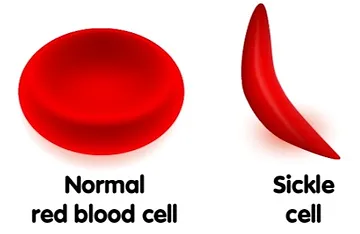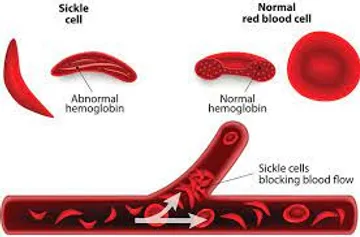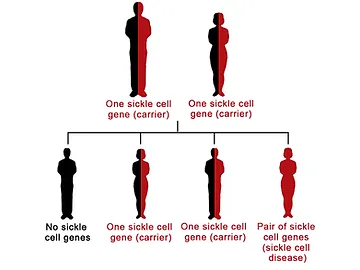
Sickle cell anemia is a genetic blood disorder that makes the body incapable of producing healthy red blood cells and thereby causes oxygen shortness in the body. It is also termed SCD. Typical red blood cells are rounded in shape whereas, people who have this kind of anemia have defects in their hemoglobin which causes Red Blood Cells to become sickle or crescent moon alike.
To date, there is no cure for sickle cell affected people. Treatments, on the other hand, can help reduce discomfort and avoid disorder complications. World sickle cell day is celebrated on 19th June 2021 every year for the awareness of this chronic disease.
The illness is known to occur mostly amongst African Americans (a 1:400 ratio for African American births) and Latinos of Caribbean descent in the United States (1:1000 or 1:1400 for Latin American children). However, the illness is also present in Greek, Arabian, Italian, Sardinian, Maltese, Turkish, and southern Asian heritage worldwide
❖ Red blood cells with a sickle shape:
Blocked blood arteries, cause extreme discomfort and deprive organs and tissues of oxygen. They get either walloped or sucked in the spleen (an organ that eliminates old cells) and are terminated. The body is unable to repair the cells that have been lost promptly. As a consequence, fewer red blood cells are produced, even those, die way before their normal life span, almost like in 10-20 days while their normal life is 100-120 days long. It results in anemia. The condition is a severe illness that often necessitates hospitalization. It usually is fatal.

Types of Sickle cell disease:
The illness can be classified into five broad types:
· Hemoglobin SS Disease:
It is the stereotypical and most dire type of sickle cell condition. It is caused when the mutated gene is inherited by both parents. Typically, people with this illness produce only sickle red blood cells and a few or none of the healthy blood cells.
· Hemoglobin SB (beta – zero) Thalassemia:
It occurs when the hemoglobin beta S gene is inherited from one parent and a hemoglobin beta0 thalassemia gene mutation is taken over from the other parent. It also resembles hemoglobin SS type because only hemoglobin-s is produced. It carries the same amount of severity as the former one.
· Hemoglobin SC Disease:
This is the second most frequent type of sickle cell anemia. It is caused when one inherits the hemoglobin beta S gene from one parent and the other parent passes on the hemoglobin C gene. However, the severity level is reduced in this case.
· Hemoglobin SB+ (Beta) Thalassemia:
The condition falls out when the hemoglobin beta S gene is passed onto the offspring from one parent and the second parent gives off a hemoglobin beta plus thalassemia gene. In such an instance, normal hemoglobin is processed in the body, but in lesser amounts. The symptoms are mild but complications may still make their way to make things difficult for the patient
Hemoglobin SD, Hemoglobin SE, And Hemoglobin SO
These variations of sickle cell anemia are rare to occur and are scantily severe.

Symptoms:
Symptoms of sickle cell anemia may start to appear from infancy (nearly five months of age). However, they may vary from one individual to another and become more evident and distinguishable through time. The following can be traits and indications of this illness:
Red Blood Cells carry oxygen throughout our bodies. Generally, a red blood cell lives for 120 days, then it is replaced, but in the case of cresented cells, they die within 10 to 12 days, causing a deficiency of blood cells in the body. It also results in fatigue and tiredness.
Pain in the bone and chest ache is the major symptom of this disease. Pain can last from hours to days. Pain occurs when these diseased red blood cells curb the blood flow throughout different parts of the body.
Joint pain and in the worst of cases, arthritis may occur. The spleen can also become dysfunctional by sickle- cells.
Making blood clots, swelling in hands and feet is some of the symptoms.
Red blood cells transporters of oxygen and vitamins throughout the entire body, allowing us to grow. In toddlers and kids, a deficiency of healthy red blood cells can slow down growth and cause delayed puberty.
Sickle cells can also damage tiny blood vessels supplied to our eyes. Therefore, it can lead to a vision problem.
There are some other signs like abdominal inflammation, pale skin and nail beds, and fever.

❖ Causes of sickle cell anemia:
Sickle cell anemia is an inherited disease, which means this disease is inherited by a child from the parents. Children can never be affected with sickle cell anemia unless both of the parents have defective hemoglobin in their blood cells. Though, if one parent is affected, they may carry a repressive sickle cells gene and are usually asymptomatic. They may, nevertheless, carry the disease-carrying genes, and pass them on to their offspring's.
➢ Complications:
Sickle cell anemia can cause various problems, ranging from blindness to leg ulcers or acute chest syndrome, or maybe pulmonary hypertension and organ damage, gallstones, and priapism and pregnancy complications.
➢ Diagnosis:
It is diagnosed with a simple blood test during the very first age within five months of age. Symptoms of sickle anemia can vary from person to person. Treatment depends on the symptoms since the cure is not the same for every patient. In some cases, it can be cured by using bone marrow transplantation.
● Social effects of sickle cell disease:
Sickle cell anemia affects 2.5 million black Americans or almost one out of every ten black people. Doctors and medical officials call it a ‘global concern’, an ‘urgent health problem’, and the country's most ignored health issue.
According to a survey, youngsters with sickle cell illness lose 16 days of school each year, with 12% missing more than 63 sessions. Due to many hospital consultations, patients frequently miss school. There has been a complaint of a widespread lack of resources in assisting students in catching up on missing coursework. There are some good instances of schools where this is not the situation, and with appropriate tools, the proper procedure may be propagated.
Black and minority ethnic people are disproportionately victims of sickle cell and thalassemia. There is still racial prejudice within the educational system, which adds to the hurdles and misconceptions that young patients with these diseases confront.
Individuals with sickle cell anemia require dry, temperate, and easily accessible accommodation. Families with sickle cell are frequently overlooked in social housing and welfare choices. Social housing providers frequently overlook the requirements of these patients. As a result, young people may be forced to live in substandard housing, which might exacerbate their symptoms.

➢ Cure:
Generally, there is no cure for this disease. However, pain can be lessened with the help of medications. Blood transfusion can also be helpful to lessen pain episodes. For some children or teenagers, stem cell transplant or bone marrow might cure the disease.
